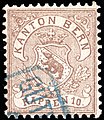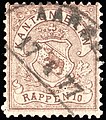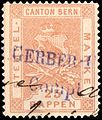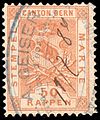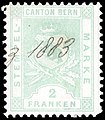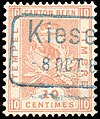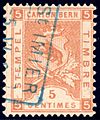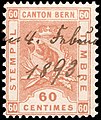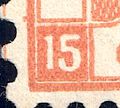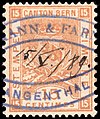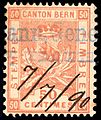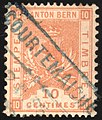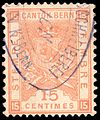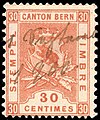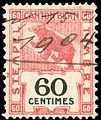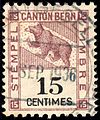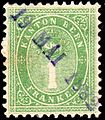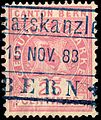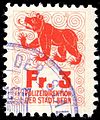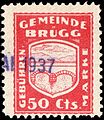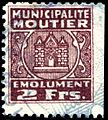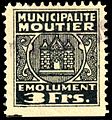World Stamp Catalogue/Bern (Switzerland)


Revenue stamps of Bern (Switzerland) and its municipalities, by type.
Canton of Bern
[edit | edit source]The canton of Bern is the second largest of the 26 Swiss cantons by both surface area and population, located in west-central Switzerland. Cantonal revenue stamps were issued for 4 different purposes (classifications A-D), and for tourism tax. Most stamps were printed by Kümmerly & Frey in Bern.
Advertisement
[edit | edit source]Arms of Bern inscribed Kanton Bern.
1865
[edit | edit source]Bern coat of arms.
-
2rp unused, green-grey
-
2rp unused, green-yellow (b)
-
3rp unused
-
3rp used
-
6rp unused
General revenue
[edit | edit source]Arms of Bern inscribed Kanton Bern.
Watermarks.
-
Watermark II large 'CB'
-
Watermark IIIa inverted 'B'
-
Watermark IV 'S'
-
Watermark IVa 'S' inverted
-
Watermark IVa 'S' inverted, pair
1865-1872
[edit | edit source]Bern coat of arms. Imperforate.

1865 without watermark
[edit | edit source]Fine print, orange to orange-brown.
-
1865, 10rp unused
-
1865, 10rp used
-
1865, 10rp used
1872 watermarked
[edit | edit source]Coarse print, in which the bear in the coat of arms has less or no fine lines. Watermark small 'CB' reading up or down (I and Ia). Large 'CB' watermark covering vertically two stamps, reading up or down (II and IIa). Known in thick (A-B) and thin (C-D) paper.
-
1872, 10rp used, orange (A)
-
1872, 10rp unused, orange (A)
-
1872, 10rp used, dark orange (aA)
-
1872, 10rp used, thin paper (aC)
-
1872, 10rp unused block of four (IIaB)
1874-1877
[edit | edit source]Perforated 11.75. 1874 watermarked large 'CB' reading up or reading down (II and IIa). 1877 watermarked 'B' normal or inverted (III or IIIa) and 'S' normal or inverted (IV or IVa). Numerous brown shades.
-
1874, used (II)
-
1874, used (II)
-
1874, used (II)
-
1874, used (II)
-
1877 brown-orange, used (III)
-
1877, used (IIIa)
-
1877, used (IIIa)
-
1877, used (IIIa)
-
1877, used (IIIa)
-
1877, used (IIIa)
-
1877, used (IIIa)
-
1877, used (IVa)
-
1878, money order with 10 rappen revenue stamp
1880
[edit | edit source]Arms of Bern inscribed Canton Bern, each corner ornamented, right text 'MARKE'. Microdot above lower left corner, the function is unknown.
Watermark 'S'
[edit | edit source]Perforations 11.5-11.75 (B), 12.75-13 (C) or mixed 11.5x11.5x13x11.5 (D).
-
5rp used (C)
-
20rp used (B)
-
20rp used (C)
-
20rp used (C)
-
25rp used (C)
-
25rp used (C)
-
30rp used (B)
-
30rp used (C)
-
30rp used (C)
-
50rp used (B)
-
50rp used (C)
-
50rp used (C)
-
60rp used (B)
-
60rp used (C)
-
60rp used (D)
-
1Fr used (C) plate flaw: open frame top left
-
10Fr used (B)
Watermark 'S' inverted
[edit | edit source]Perforations 11.5-11.75 (E), 12.75-13 (F).
-
5rp used (F)
-
10rp used (E)
-
10rp used (F)
-
15rp used (E)
-
15rp used (F)
-
20rp used (F)
-
25rp used (F)
-
50rp used (E)
-
50rp used (F)
-
60rp used (F)
-
90rp used (F)
-
1Fr used (E)
-
2Fr used (E)
-
2Fr used (E)
-
2Fr used pair (E)
-
2Fr used (F)
-
2Fr used (F)
-
5Fr used (F)
-
5Fr used (F) no microdot
-
10Fr used (E)
-
10Fr used (E)
Value 15 in each corner
[edit | edit source]

Design changes: right text 'TIMBRE', '15' in each corner. Small numeral above lower right 15: 1, 2 (a), 3 (b), 4 (c) or 5 (d). Watermark 'S' (A) or inverted (B). perforated 12.75x10.25. Occasionally a microdot above lower left value (indicated ·). The function of this dot is unknown.
The theory concerning the small numerals is that there were five types of stamps transferred to the lithographer's stone, making up the complete plate for the sheets of the 1880 and 1881 issue. The stamps in rows carry the same number, the stamps in columns are sequenced downwards (cf. M.N. Thaler).
-
15rp used, · and '3' (bA)
-
15rp used, '4' (cA)
-
15rp used, '5' (dA)
1881
[edit | edit source]Value in centimes. Watermark 'S' and perforated 11.5 (A) or 12.75x10.25 (B) or inverted 'S' and perforated 12.75x10.25 (C). Some stamps show a microdot above the lower left numeral (indicated ·). Various types of cancellation existː
- Square, circular or oval bank cancel;
- Bank cancel with manuscript date;
- Manuscript date and/or name;
- Railway cancellation;
- Postal cancellation (scarcer).
1881 A-Cː without numeral and right 'K'
[edit | edit source]No numeral and 'K' above lower right value.
Watermark 'S', perforated 12.75x10.25 (B).
-
10c - (B)
-
10c - (B)
-
10c - (B)
-
10c - (B)
-
10c - (B)
-
20c - (B)
-
20c - · (B)
-
30c - (B)
-
30c - · (B)
-
60c - (B)
-
30c document detail - (B)
-
30c - (B) on 1889 fire insurance policy
Watermark inverted 'S', perforated 12.75x10.25 (C).
-
10c postal cancel (BR)EULEUX - (C)
-
10c - (C)
-
10c 'BIELER VOLKSBANK' - (C)
-
10c - (C), plate flaw dot above center '10'
-
10c - (C)
-
10c - (C) pair
-
15c - (C)
-
20c - · (C)
1881 aB-aCː Numeral and 'K'
[edit | edit source]Subtype a: with micro numbers above lower left value and 'K' above lower right value. The small 'K' is the first initial of the printing company Kümmerly & Frey. Numerals 1-5 exist for the 5c, 10c, 30c and 60c. Perforation 11.5 is not known with small numerals.
Details of the 10c lower left corner with numerals 1-5:
-
10c '1' detail - (aC 1-K)
-
10c '2' detail - (aB 2-K)
-
10c '3' detail - (aC 3-K)
-
10c '4' detail - (aB 4-K)
-
10c '5' detail - (aB 5-K)
Watermark 'S', perforated 12.75x10.25 (B).
-
10c - (aB 1-K)
-
10c COURFAIVRE - (aB 1-K)
-
10c - (aB 2-K)
-
10c - (aB 2-K)
-
10c - (aB 3-K)
-
10c - (aB 4-K)
-
10c SAIGNELÉGIER - (aB 4-K)
-
10c - 'ST URSANNE' (aB 4-K)
-
10c Simplon Train EPV - (aB 4-K)
-
10c - (aB 5-K)
-
10c - (aB 5-K)
-
10c EILGUT BERN - (aB 5-K)
-
10c - 'ST URSANNE' (aB 5-K)
-
10c LUCERNE TRAIN - (aB x-K)
-
10c KIESEN - (aB x-K)
Watermark inverted 'S', perforated 12.75x10.25 (C).
-
10c - (aC 1-K)
-
10c cancel LANGE(NTHAL) - (aC 1-K)
-
10c - (aC 2-K)
-
10c - (aC 3-K)
-
5c railway St IMIER - (aC 4-K)
-
5c postal (BR)EULEUX - (aC ·4-K)
-
10c - (aC 4-K)
-
30c pair - (aC ·4-K)
-
10c - (aC 5-K)
-
10c - (aC 5-K) plate flaw: dot in 'BERN'
-
30c pair - (aC ·5-K)
Documents with stamps perforated 12.75x10.25 (B or C).
-
2x 5c detail - (a 4-K, a 5-K)
-
1892 money order with 2x5c - (a 4-K, a 5-K)
-
10c - (aC 3-K) on reverse of day report
-
10c detail - (a 1-K)
-
1888 money order with 10c - (a 1-K)
1881 aaBː Numeral without 'K'
[edit | edit source]Subtype aa: Micro number (1-5) above lower left value but without 'K' above lower right value. The micro numbers are considerably smaller then those of type a. Perforation 12.75x10.25. Stamps with perforation 11.5 are not known having micro numbers.
-
60c - (aaB) '1'
-
60c - (aaB) '2'
-
60c - (aaB) '5'
1886
[edit | edit source]Design changes: leaves on the left, no numeral above lower right value, but numerals exist for the 15c: 1 (a), 2 (b), 3 (c), 4 (d) or 5 (e). Watermark 'S' (A) or inverted (B). Perforated 12.75x10.25. No microdot.
The 15c is known in two types, thick (I) or thin (II) lower left '15'.
-
15c, type I
-
15c, type II
-
15c used (A) type I
-
15c used (dA -'4') type I
-
15c used pair (fA) type II
-
25c unused (A)
-
50c unused (A)
-
50c used (A)
-
2fr used (B)
-
5fr used (A)
1892-1902
[edit | edit source]
Value in centimes and design changes: Month (Roman numerals) and year inscribed on one of the lower left leaves (ranging from X.92 to X.02). Value in each corner, but no numerals or letter 'K' above lower value. Watermark 'S' (A) or inverted (B, uncommon), perforated 12.75x10.25. From 10-1898 (X.98) the corner '10' has a top dash. The 15c thick (I) or thin (II) corner numerals. No microdot.
-
5c - (A III.95)
-
5c postal SUMISWALD - (A I.99)
-
10c (KIRC)HBERG - (A X.92)
-
10c COURTEMAICHE - (A VI.94)
-
10c (L)ANGENTHA(L) - (A III.95)
-
10c (B)ERNE (J.)S. G.V. - (A III.96)
-
10c - (A VI.96)
-
10c - (A X.96)
-
10c Burgdorf - (A II.97)
-
10c (C)OURGEN(AY) - (A VIII.97)
-
10c BERN(E) J.S. G.(V.) - (A XII.97)
-
10c Wangen a(d Aare) - (A XII.97)
-
10c Wangen a(d Aare) - (A VI.98)
-
10c Simpl(on) - (A IX.98)
-
10c BERN(E) (J.)S. G.V. - (A X.98)
-
10c (LAN)GNAU - (A I.99)
-
10c PORRENTRUY - (A V.99)
-
10c (C)OURGEN(AY) - (A IX.99)
-
10c - (A I.00)
-
10c (RE)CONVILIE(R) - (A V.00)
-
10c plate flaw at left - (A V.00)
-
10c LOTZ(WIL) - (A VIII.00)
-
10c PORRENTRUY - (A I.01)
-
10c (C)OURFAIV(RE) - (A V.01)
-
10c GLOVEL(IER) - (A V.01)
-
10c - (A IX.01)
-
10c (B)ASSECO(URT) - (A II.02)
-
10c - (A VII.02)
-
10c (INT)ERLAKEN - (A X.02)
-
15c - (AI VII.93) type I
-
15c - (AI VI.94) type I
-
15c - (AI VI.94) type I
-
15c - (AI II.97) type I
-
15c - (AII X.99) type II
-
15c - (AII V.01) type II
-
15c - (AII X.02) type II
-
25c - (A IX.98)
-
60c - (A V.99)
-
1Fr - (A IX.97)
-
2Fr - (B III.96)
1893-1898
[edit | edit source]
A large group with numerous different types (estimated 142). Month (Roman numerals) and year inscribed on one of the lower right leaves, ranging from III-93 to VI-98. Watermark 'S', perforated 12.75x10.25. The 5c, 10c and 30c can have small numerals (1-5) above lower left value and letter 'K' above lower right value. The 60c can have small numerals (1-5) above lower left value without letter 'K' above lower right value. Some stamps show a microdot above lower left value, numerals can sometimes be preceded by it (indicated ·).
- 5c № 51: 3 dates, with or without numerals: 3x6=18 types
- 10c № 52: 7 dates, with or without numerals: 7x6=42 types
- 20c № 53: 3 dates, without numerals: 3 types
- 30c № 54: 8 dates, with or without numerals: 8x6=48 types
- 60c № 55: 5 dates, with or without numerals (without 'K'): 5x6=30 types
- 1fr № 56: 1 date, without numerals: 1 type
-
5c unused - (VII.93, 1-K)
-
5c (COU)RTEMAICHE - (VII.93, 1-K)
-
5c - (II.97, 1-K)
-
5c - (III.98, 1-K)
-
10c (INTERL)AKEN Ost - (III.93, 2-K)
-
10c - (VII.93, 2-K)
-
10c - (I.94, 2-K)
-
10c - (I.94, 4-K)
-
10c - (X.94, 1-K)
-
10c - (VIII.95, 2-K)
-
10c - (XII.95)
-
10c (R)UBIGE(N) - (XII.95, 2-K)
-
10c - (XII.95, 5-K)
-
10c MEIRINGEN - (III.98 - )
-
20c - (VII.93 - ·)
-
20c - (VIII.95)
-
20c - (XII.97)
-
30c - (III.93 ·3-K)
-
30c - (III.93 ·4-K)
-
30c - (I.94 ·3-K)
-
30c - (X.94 ·1-K)
-
30c - (VIII.95 5-K)
-
30c - (III.96)
-
30c - (II.97 ·2-K)
-
30c - (VI.98 - ·)
-
60c - (X.93 4)
-
60c - (II.97 4)
-
1Fr - (X.93)
1902
[edit | edit source]Month (Roman numerals) and year inscribed on one of the lower left leaves. Watermark 'S', perforated 12.75x11.25, black.
-
5c - (VII.02)
-
10c - (X.02)
-
60c - (X.02)
1903
[edit | edit source]

Changed design. This group bears the name of one of the owners of the printing company 'H Kümmerly' (Hermann Kümmerly) below the front right paw of the bear. Watermark IV ('S' - A), 10c exists with inverted 'S' (B). Perforated 12.75x10.25. Numerals dark green or black (a), red from 1Fr.
-
5c - (A)
-
10c - (aA)
-
15c - (aA)
-
30c - (A)
-
50c - (A)
-
60c - (A)
-
1Fr - (A)
1906
[edit | edit source]
Changed, less detailed design without engraver's name. Numerals black, red from 1Fr. Five types can be distinguished:
- A: Watermark IV ('S'). Perforated 12.75x10.25. Brown-lilac to red-brown on yellowish paper,
- B: Watermark IV ('S'). Perforated 12.75x10.25. Lilac-brown/red on white paper,
- C: Watermark IVa ('S' inverted). Perforated 12.75x10.25. Lilac-brown/red on white paper,
- D: Watermark IV ('S'). Perforated 9.75x12.5. Lilac-brown/red on white paper,
- E: Watermark IVa ('S' inverted). Perforated 9.75x12.5. Lilac-brown/red on white paper.
Type A-C: Perforated 12.75x10.25.
[edit | edit source]-
5c - (B)
-
10c - (B)
-
15c - (B)
-
20c - (A)
-
30c - (B)
-
30c pair - (C)
-
50c - (B)
-
60c pair - (B)
-
60c pair - (C)
-
1Fr - (B)
-
2Fr - (B)
-
5Fr - (B)
-
5Fr pair - (C)
-
10Fr - (B)
-
50Fr - (B)
-
50Fr strip of 4 - (C)
-
15c on fragment - (B/C)
-
10c, 30c, 1Fr, 5Fr on fragment - (B/C)
-
30c - detail of notary document
-
30c - detail of notary document, with 1906 issues
Type D-E: Perforated 9.75x12.5.
[edit | edit source]-
10c - (D)
-
15c - (D)
-
15c strips of 4 - (D/E)
-
60c - (D)
-
1Fr (1903-1930) and 30c - (D/E) on fragment
-
1929-08-28 receipt with 10c revenue (D or E)
1914
[edit | edit source]Design like 1906, overprinted 'WECHSELSTEMPEL'. Watermark IV ('S'), perforated 12.75x10.25.
-
10c
-
15c
-
25c
-
30c
1930+
[edit | edit source]
No decoration in lower part of value frame. Watermark IV ('S' - A) or watermark IVa ('S' inverted B). Perforated 9.75x12.5.
-
10c - (B)
-
30c - (B)
-
60c - (B)
-
10Fr - (B)
1934+
[edit | edit source]
Square undecorated value frame. Watermark IV ('S' - A) or watermark IVa ('S' inverted B). Perforated 9.75x12.5.
-
15c - (B)
-
20c - (B)
-
25c - (B)
-
30c - (A)
-
50c - (B)
-
30c on detail of a subpoena
-
1938 Postal order fragment. Mixed usage of general and fixed fee revenue stamps.
-
20c strip of 4 (1935 issue) and 1Fr on fragment
Fixed fees
[edit | edit source]Purpose classification C. Intended for taxation of a precisely defined service, mixed usage with general revenue stamps was common practice (eg. the 1938 postal cheque fragment above).
1878
[edit | edit source]Arms of Bern inscribed Kanton Bern. Watermark 'B' (III), 50c., 1Fr. and 2Fr. are known with inverted 'B' (IIIa). Perforated 11.75. Numerous shades.
-
10rp - (A)
-
20rp - (A)
-
20rp - (A)
-
25rp - watermark 'B' inverted (a)
-
50rp - (A)
-
50rp dark red on fragment - (bA)
-
1Fr - (A)
-
2Fr - (A)
-
2Fr pair - (B)
-
5Fr - silver (A)
-
5Fr - black (aA)
-
10Fr - (A)
-
10Fr - (aA)
1884
[edit | edit source]Arms of Bern inscribed Canton Bern and Gebührenmarke. Watermark 'S' (A), some values known with inverted 'S' (B). Perforated 12.75x10.25.
-
10c - (bA)
-
10c pair - (bA)
-
20c - (A)
-
25c - (3A)
-
50c - (B)
-
50c - (aB)
-
50c dark red on fragment
-
10, 20 and 50c on fragment
-
80c - (A)
-
1Fr grey-brown - (A)
-
1Fr light grey-brown - (aA)
-
1Fr light grey-brown pair- (aB)
-
2Fr - (A)
-
1-2Fr on fragment
-
5Fr - (B)
-
5Fr - (№ 18aA)
-
10Fr - (№ 19A)
-
50Fr - (№ 20A)
-
Close-up of judicial document with 1, 2 and 10Fr and 60c pair
1903-1918-1930
[edit | edit source]
Value frame round at top. Up to 80c the numeral can be either in dark green or black (subtype a-c). Four main types can be distinguished:
- A: Watermark IV ('S'). Perforated 12.75x10.25,
- B: Watermark IVa ('S' inverted). Perforated 12.75x10.25,
- C: Watermark IV ('S'). Perforated 9.75x12.5,
- D: Watermark IVa ('S' inverted). Perforated 9.75x12.5.
Type A-B: perforated 12.75x10.25
[edit | edit source]-
10c - green-grey (bA)
-
15c - (A)
-
15c - (aA)
-
20c - (A)
-
25c - (A)
-
25c - (aA)
-
50c, 30c on fragment
-
50c - (A)
-
50c - (aA)
-
50c pair - (aA)
-
50c pair - (bA)
-
50c - (a), 1906 15c - (A) on fragment
-
50c - (a) on fragment
-
50c - (a)
-
50c - pale olive (cA)
-
50c - (c) on fragment
-
50c - (aB)
-
50c - (aD) on fragment
-
80c - (A)
-
80c - olive-brown (bA)
-
1Fr - (A)
-
1Fr - (A)
-
1Fr block of four - (B)
-
1Fr, 5Fr on fragment
-
1Fr, 2Fr on fragment
-
2Fr pair - (A)
-
2Fr rose-brown - (A)
-
2Fr - rose-brown (A)
-
2Fr red-brown - on fragment
-
5Fr light green, thin numeral - (A)
-
5Fr light green, thick numeral - (A)
-
5Fr olive - (aA)
-
10Fr - (A)
-
10Fr - violet-grey (aA)
-
50Fr - (A)
-
100Fr - (A)
-
200Fr - (A)
-
1909 certified copy of legal guardianship with 10c, 50, and 60c
-
1926 subpoena 'Vorladung' with 2Fr, 15c
Type C-D: perforated 9.75x12.5
[edit | edit source]-
20c - (aC)
-
20c - (aC)
-
50c - (cD)
-
50c - (D)
-
50c block of 6 - (D)
-
50c - (aD)
-
50c block of 6 - (aD)
-
80c - (bD)
-
1Fr - (C)
-
1Fr - (D)
-
2Fr - (C)
-
2Fr - (C)
-
2Fr strip of three - (C)
-
2Fr - (D)
-
2Fr block of 4 - (D)
-
3Fr - (D)
-
3Fr - (D)
-
3Fr - (aD)
-
3Fr pair - (aD)
1933+
[edit | edit source]
Square value frame, perforated 9.75x12.5. Three main types can be distinguished:
- A: Watermark IV ('S'),
- B: Watermark IVa ('S' inverted),
- C: No watermark.
Watermark IV ('S')
[edit | edit source]-
20c
-
20c pair
-
50c
-
50c
-
50c strip of 3
-
50c - (a)
-
50c pair - (a)
-
1Fr - blue value
-
1Fr - dark blue value (a)
-
2Fr
-
2Fr pair, notary office cancel
-
2Fr strip of 4
-
2Fr block of 4
-
3Fr
-
3fr - (a)
-
3Fr - (a)
-
5Fr
-
5Fr - (a)
-
5Fr
-
5Fr
-
5Fr pair
-
5Fr - (a)
-
5Fr strip of 3 - (a)
-
10Fr
-
10Fr pair
-
10Fr
-
20Fr
Watermark IVa (inverted 'S')
[edit | edit source]-
10c pair
-
20c
-
20c pair
-
20c pair
-
25c
-
50c
-
50c
-
1Fr
-
1Fr pair
-
2Fr
-
2Fr pair
-
2Fr strip of 4
-
2Fr
-
5Fr
-
5Fr (a)
-
10Fr
-
20Fr
Stamps on fragment
[edit | edit source]-
1Fr (a) and 50c police cancel
-
1Fr used in MOUTIER
-
1Fr used in DELEMONT
-
3Fr used in DELEMONT
-
3Fr and 5Fr used in PORRENTRUY
-
5Fr on fragment used in BERN
War tax
[edit | edit source]Fixed fees (50c. № 65, 1Fr. № 48a and 2Fr. № 50) overprinted 'KW' (Kriegswirtschaftsamt).
-
50c
-
1Fr
-
2Fr
Bern City
[edit | edit source]Police tax
[edit | edit source]1908
[edit | edit source]
Bear touches upper diagonal in arms. Perforated 11.5.
-
10c
-
20c
-
50c
-
1Fr
-
2Fr
-
2Fr
-
5Fr
-
5Fr
-
10Fr
-
10Fr - (a)
-
50Fr
1908-1927
[edit | edit source]Smaller diagonal dash on '1' and smaller ornament in top corners. Perforated 11.5.
-
1Fr - detail
-
1Fr golden
-
1Fr silver
1927
[edit | edit source]Bear is smaller and does not touch upper diagonal in arms. Perforated 11.

-
30c
-
50c
-
1Fr
1939
[edit | edit source]New design. Imperforate (A) or perforated 11 (B).
-
20rp - (B)
-
30rp - (B)
-
50rp - (B)
-
60rp - (B)
-
3Fr - (B)
-
10rp and 1Fr on fragment - (B)
Chancellery
[edit | edit source]1930
[edit | edit source]Light (A) or dark colors (B). Perforated 11 (A) to 11.5 (D).
-
50rp - (A)
-
10Fr - (B)
-
25Fr - (D)
Legal guardian office
[edit | edit source]-
5Fr
Tourism
[edit | edit source]Colored paper with wide shield, inscribed Beherbergungs-Abgabe (Mountain Lodge Duty). Perforated 10.75-11 (A) or 11.25-11.5 (B). Wallace № 1-16.
-
1944, 20c unused (Wallace № 4)
Markings
[edit | edit source]Three different categories of revenue markings can be distinguished:
- Hand stamps (A), from 1805.
- Preimprinted marking (B).
- Relief (dry) marking (C).
-
1807, 1 Batz hand stamp (A)
-
1824, 1 Batz hand stamp (A)
-
1805, 1 Batz. relief print (C)
-
1807, 1 Batz. relief print (C)
-
1860, 10rp relief print (C)
-
1896, 60rp relief print (C)
-
1918, 60rp relief print (C)
-
1828, 1 Batz hand stamp and relief print on document (A, C)
-
1830, 1 Batz hand stamp and relief print on document (A, C)
-
1918, 60rp relief print (C) and 25c fixed fee stamp on Heimatschein.
Municipalities of the canton of Bern
[edit | edit source]There are 351 municipalities in the canton of Bern (as of January 2017), of which some issued revenue stamps.
Aarberg
[edit | edit source]In Aarberg 4 different stamps were issued in 1904. Perforated 11.5 (A) or 14 (B), and next to these issues 28 special printings (S) exist imperforate (A), perforated 11.5 (B,C) or 14 (D).

-
30c unused (B)
-
50c unused (B)
Special printings.
-
10c unused (A)
-
10c unused (B)
-
10c unused (A)
-
20c unused (A)
-
20c unused (C)
-
20c unused (D)
-
20c unused (A)
-
20c unused (B)
-
20c unused (A)
-
30c unused (B)
-
30c unused (C)
-
30c unused (D)
-
30c unused (A)
-
30c unused (B)
-
50c unused (A)
-
50c unused (C)
-
50c unused (A)
-
50c unused (C)
-
50c unused (D)
-
50c unused (B)
-
30c - 50c - 20c se-tenant
Albligen
[edit | edit source]Albligen (former French name: Albenon) is a former municipality in the Bern-Mittelland administrative district in the canton of Bern in Switzerland. 4 different stamps were issued between 1910 and 1913.

-
1913, 10Rp used
-
1913, 20Rp used
Biel / Bienne
[edit | edit source]Biel/Bienne is a town and a municipality in the Biel/Bienne administrative district. 88 different stamps were issued between 1892 and 1935.

Municipal tax
[edit | edit source]-
1892, 25c used
-
1892, 1Fr used (a)
-
1892, 1Fr used
-
1903, 50c used (B)
-
1903, 2Fr used (B)
-
1932, 2Fr unused (aB)
Documents
[edit | edit source]1902-1919 issues. Schriften-Controlle, perforated 11.5. or 13.25 (1910 - B). 5 types can be distinguished of the 1902 issue, based on small line deformations in the lower half of the stamp.
-
1902, 20c used (T2)
-
1902, 45c unused (T3)
-
1902, 50c used (T3)
-
1902, 75c blue, unused (T3)
-
1902, 75c blue-green, used (a, T2)
-
1902, 80c unused (T3)
-
1902, 1.30Fr used (T2)
-
1910, 50c used (B)
-
1910, 1.30Fr used (A)
-
1919, 50c used
-
1919, 80c used
Police
[edit | edit source]1918-1931. Polizei-Commissariat, perforated 11.5.
-
1918, 20c unused
-
1918, 50c used
-
1918, 1Fr used
-
1918, 5Fr unused
City of Biel
[edit | edit source]1919-1933.
-
1921, 20c used
-
1921, 5Fr unused
-
1921, 1Fr unused
-
1921, 2.60Fr used
-
1926, 50c used
-
1933, 20c used
-
1933, 1fr used (C)
-
1933, 2Fr used
Brügg
[edit | edit source]Brügg is a municipality in the Biel/Bienne administrative district. 12 different stamps were issued between 1907 and 1935.

-
1935, 1Fr used
-
1935, 50c used
Burgdorf
[edit | edit source]Burgdorf is the largest city in Emmental. 12 different stamps were issued in 1917. Four different perforations exist: 11.25x11.5 (A), 13 (B), 11.25x13 (C) and imperforate (D).

-
5c used (A)
-
10c used (B)
-
20c used (A)
-
20c used (B)
-
30c used (A)
-
30c used (B)
-
50c used (A)
-
1Fr used (A)
-
2Fr used (A)
Corgémont
[edit | edit source]Corgémont is a municipality in the Jura bernois administrative district. 17 different stamps were issued.

-
20c used
Court
[edit | edit source]Court is a municipality in the Jura bernois administrative district. 6 different stamps were issued in the 1900's.

-
10c unused
-
20c used
-
50c unused
-
1Fr unused
-
5Fr unused
Evilard (BE)
[edit | edit source]Evilard is a municipality in the Biel/Bienne administrative district. 14 different stamps were issued, perforated either 10 (A) or 11.5 (B).

-
10c used (B)
-
50c unused (B)
-
1Fr unused (B)
Guggisberg
[edit | edit source]Guggisberg is a municipality in the Bern-Mittelland administrative district. 7 different stamps were issued in 1908 and 2 tourism tax stamps.

-
10c used (B)
-
20c used (B)
-
1Fr used (B)
Huttwil
[edit | edit source]Huttwil is a municipality in the Oberaargau administrative district. 29 different stamps were issued from 1903.

-
10c used
-
20c used
-
20c used
-
30c used
-
40c used
-
50c used
-
1Fr used
-
2Fr used
Interlaken
[edit | edit source]Interlaken is a statistic town and municipality in the Interlaken-Oberhasli administrative district. 31 different stamps were issued between 1926 and 1933. Variations exist, some can be distinguished by measuring the distance between value numeral and 'Cts' or 'Fr'.

-
1926, 5c used
-
1926, 10c used
-
1926, 30c used (a)
-
1926, 50c used
Köniz
[edit | edit source]Köniz is a statistical town and a municipality in the Bern-Mittelland administrative district right on the southern border to Bern. 43 different stamps were issued from 1901.

-
1901, 50rp
-
1903, 50rp
-
1920, 20c - (A)
-
1920, 20c - (B)
Langenthal
[edit | edit source]Langenthal is a town and a municipality in the district of Oberaargau. 36 different stamps were issued between 1907 and 1950.

-
1907, 20c used (A)
-
1907, 50c used (A)
Laufen / Laufon (1994: BL)
[edit | edit source]Laufen is currently a municipality and the capital of the district of Laufen in the canton of Basel-Country. 7 different stamps were issued in 1908, perforated either 11 (A) or 11.5 (B).

-
20c unused (B)
-
30c used (B)
-
1Fr used (A)
-
20c-1Fr used on fragment (B-bB)
Lützelflüh
[edit | edit source]Lützelflüh is a municipality in the administrative district of Emmental. 15 different stamps were issued between 1904 and 1957.

-
1904, 50c used
-
1906, 50c used
-
1908, 50c used
Madretsch
[edit | edit source]Madretsch (formerly Mardrez) is a former commune in the Swiss canton of Bern. Now a suburb of Biel/Bienne, which it joined in 1920. 5 different stamps were issued in 1903.

-
20c unused
-
30c unused
-
50c unused
-
50c unused
-
75c used
-
75c used
-
1Fr unused
Mett
[edit | edit source]Mett is a former commune in the Swiss canton of Bern. Now a suburb of Biel/Bienne, which it joined in 1920. 5 different stamps were issued in 1916.
-
10c used
-
20c used
Moutier
[edit | edit source]Moutier is a municipality in the Jura bernois administrative district. 22 different tax stamps were issued between 1915 and 1945.
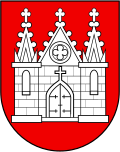
-
1915, 10c used
-
1915, 10c unused
-
1915, 20c unused
-
1915, 50c used
-
1915, 5Fr used (a)
-
1945, 20c used
-
1945, 20c used (a)
-
1945, 2Fr used (B)
-
1945, 3Fr used (B)
Neuveville, La
[edit | edit source]La Neuveville is a municipality in the Jura bernois administrative district. 8 different tax stamps were issued, dates are unknown.

-
1Fr, unused
-
50c, unused (a)
-
3Fr, used
Nidau
[edit | edit source]Nidau is a municipality in the Biel/Bienne administrative district. 19 different tax stamps were issued from 1910.

-
1910, 10c used
-
1910, 15c used
-
1928, 10c used
-
1928, 20c used
-
1928, 20c used (C)
Niederbipp
[edit | edit source]Niederbipp is a municipality in the Oberaargau administrative district. 19 different tax stamps were issued to c. 1976.

-
10c used (A)
-
10c used (B)
-
20c used (A)
-
50c used (B)
-
1Fr used (B)
Reconvilier
[edit | edit source]Reconvilier is a municipality in the Jura bernois administrative district. 9 different tax stamps were issued between 1904 and 1919.

-
1904, 50c used, bisected usage was allowed
-
1919, 10c black on blue-grey used
-
1919, 10c black on blue used (a)
-
1919, 20c red on yellow (a)
-
1919, 30c carmine on lilac-rose
Riggisberg
[edit | edit source]Riggisberg is a municipality in the Bern-Mittelland administrative district. 4 different tax stamps were issued in 1921.

-
1921 20rp
Roggwil
[edit | edit source]Roggwil, Bern is a municipality in the Oberaargau administrative district. 34 different tax stamps were issued from 1916.

-
1920 10rp
-
1920 20rp
Saanen
[edit | edit source]Saanen is the capital of the Obersimmental-Saanen administrative district. 25 different tax stamps were issued, dates are unknown.

-
20c
-
50c
-
1Fr
-
50rp
-
1Fr
Saint-Imier
[edit | edit source]Saint-Imier is a municipality in the Jura bernois administrative district in the canton of Bern. It is located in the French-speaking Bernese Jura (Jura Bernois). From 1925 13 different tax stamps are known. Saint-Imier also issued school revenues, unlisted by catalogues.

-
10c school revenue
-
10c school revenue
Spiez
[edit | edit source]Spiez is a town and municipality on the shore of Lake Thun in the Bernese Oberland region of the Swiss canton of Bern. It is part of the Frutigen-Niedersimmental administrative district. Only the date of later issue (1938) is known.

-
10c (A)
-
20c (A)
-
50c (A)
Steffisburg
[edit | edit source]Steffisburg is a municipality in the administrative district of Thun in the canton of Bern. 18 different tax stamps were issued.

-
30c (B)
Sumiswald
[edit | edit source]Sumiswald is a municipality in the district of the Emmental administrative district in the canton of Bern. 49 different tax stamps were issued from 1902 to 1975.

1902
[edit | edit source]'e' of 'Gebühr' slanted.
-
Slanted 'e' detail
-
10c
-
30c
-
50c
1905
[edit | edit source]-
1905 detail
-
10c
-
20c
-
30c
-
40c
-
50c
-
1Fr
Ca. 1917
[edit | edit source]Without dots before and after 'SUMISWALD'.
-
1917 detail
-
10c
-
20c
-
50c
Ca. 1916
[edit | edit source]Design in blue.
-
1Fr (B)
-
3Fr (B)
Tavannes
[edit | edit source]Tavannes is a municipality in the Jura bernois administrative district in the canton of Bern. 31 different tax stamps were issued.

-
10c
-
20c
-
50c
-
5Fr
-
20c
-
20c





















